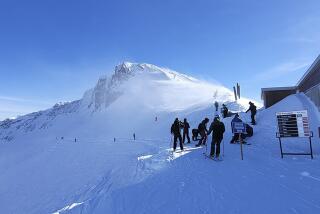In Aspen, a Difficult, Unforgiving Runway
ASPEN, Colo. â Skiers who fly in here for white-knuckle experiences offered by the downhill slopes may well get their first serious adrenaline rush as their aircraft land in this high-mountain bowl.
Unlike the long, measured approaches pilots can take at flatland airports, the ones who fly into the Aspen airport must begin a series of quick âstep-downsâ as soon as they clear a mountain range to the west.
For the record:
12:00 a.m. April 11, 2001 For the Record
Los Angeles Times Wednesday April 11, 2001 Home Edition Part A Part A Page 3 Metro Desk 1 inches; 20 words Type of Material: Correction
Aspen map--A map that accompanied a March 31 story on a plane crash in Aspen, Colo., should have labeled the elevations as meters instead of feet.
At that point, about two to three miles from the runway, pilots who can see their target must descend 2,400 feet in about a minute. If the landing strip is shrouded in clouds, they must pull out of their approach and either circle around and try again, or fly elsewhere.
Even if pilots think they have a clear shot at the 7,004-foot runway, the mountainâs capricious weather can suddenly roil their path and obscure their vision in the last, most critical moments of an approach, veteran pilots say.
These factors are compounded at night--when Thursdayâs crash of a Gulfstream III charter occurred, killing 18 passengers.
In darkness, pilots may clearly see the lights of the runway but not perceive the nearby mountainsides, which appear as an ambiguous black wall.
âWhen you approach LAX, you can be too high or low, or too right or left, and still adjust and make a landing,â said Lear jet pilot Irv Nokes. âBut when you land here, youâre shooting an approach with real walls on one side of you. Itâs like shooting through a mine shaft. Thereâs little room for error.â
A Federal Aviation Administration Web site includes concerns about the Aspen/Pitkin County Airport: âCaution: High rates of descent may be required due to terrain and local procedures.â
âPilots unfamiliar with the area are discouraged from operating during periods of reduced visibility.â
At least one charter pilot heartily agreed. âThis is a real doozy,â said Paul Perkins, who has flown into Aspen only four times. âYou canât afford to be off. Itâs not an airport you want to have a pilot bring you down into at night if heâs never been here before.â
The Gulfstreamâs pilot, Bob Frisbie, had logged more than 10,000 flight hours and First Officer Peter Kowalczyk had accrued more than 5,500, according to Avjet Corp. of Burbank, which managed and operated the 20-year-old jet that was in Thursdayâs accident.
Frisbie was an old hand at flying into Aspen/Pitkin County Airport--his last trip was only a few weeks ago, Avjet officials said.
Familiarity with the terrain is vital, said passengers who flew into Aspen on Friday and echoed the pilotsâ observations. Several passengers said they dug their fingernails into the armrests and held their breath as their planes flew just 300 feet over Thursday nightâs crash site.
âThe mountains on either side, the turbulence, thatâs whatâs scary,â Maria Imperatori said moments after arriving with her husband for a week of skiing.
She said she learned of the fatal crash only after she already was airborne in a United Airlines Express 88-passenger British Aerospace jet from Denver.
Pilots insist that if one follows the published guidelines for approaches with appropriate caution, aircraft can land in Aspen safely--and they do, tens of thousands of times a year.
The airport is Coloradoâs third busiest. Last year, the three commercial airlines that serve Aspen safely delivered more than 200,000 passengers without incident. Additionally, general aviation aircraft--including large charters and sleek corporate jets, landed more than 45,000 times in 2000--more than 100 a day, according to airport figures.
But pilots never take landing in Aspen for granted, they say.
Old-timers recall a crash of a charter jet in 1970 that took 10 lives when, after approaching the airport, it turned at the last minute and crashed into a hill.
âBecause of the mountains and the weather conditions, you canât be off on your numbers,â said Perkins. âThe low ceilings [of cloud cover] come and go pretty quickly. Even as a pilot is on his final approach, the visibility can go down.â
Another pilot, Dave Schurman, said he has flown corporate aircraft into Aspen more than 100 times in six years, and only through his multiple daytime landings does he have confidence to land at night.
âYou have to know where the terrain is so, when you transition from clouds [and instrument flying] to visual, you know where the hills are, because you just canât see them at night,â he said. âTheyâre like a black hole.â
(BEGIN TEXT OF INFOBOX / INFOGRAPHIC)
Flight Dangers
Pilots flying into the Aspen airport, which is one of the nationâs trickiest, must begin a series of quick âstep-downsâ as soon as they clear a mountain range to the west. Two to three miles from the runway, pilots must descend 2,400 feet in about a minute. Weather and darkness are also factors. It was dark Thursday when a Gulfstream III charter crashed, killing 18 people.
Plane crashes 500 yards short of runway
*
Topographic illustration by PETER PAULEY and THOMAS McKAY / Denver Post
More to Read
Sign up for The Wild
Weâll help you find the best places to hike, bike and run, as well as the perfect silent spots for meditation and yoga.
You may occasionally receive promotional content from the Los Angeles Times.






